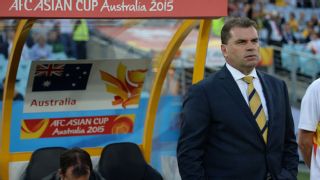If four goals against minnows Kuwait in their opening Group A game were to be expected, the Socceroos properly announced themselves at the Asian Cup with a 4-0 win Tuesday against Paul Le Guen's well-organised Oman team.
Here are three points from the game in Sydney:
1. Ange's new midfield tweak bears fruit
It's been one of the most cited facts in Australian football media since the World Cup. Heading into this tournament, no player, apart from Tim Cahill, had scored a goal from open play during the Ange Postecoglou era.
With an injury to Tom Rogic, the legs of the mercurial Mark Bresciano fading, and Mustafa Amini not getting the game time to develop sufficiently, Australia went into the Asian Cup without a recognised No. 10 -- a playmaker to pull the strings and pose questions of opposition defences.
But two games into the Asian Cup and the goals from open play have started flowing. Massimo Luongo, James Troisi and Matt McKay have all been tried in the dual No. 8 roles. The trio have created numerous chances while getting on the scoresheet themselves.
Some may have questioned McKay and Troisi starting ahead of arguably more gifted ballplayers. But their industry and determination to get both forward and back has delivered for the hosts. They've dominated possession -- 72 percent in the first half against Oman -- and provided a greater threat in the final third.
2. Socceroos' wide men find their teeth.
A source of major frustration during the World Cup was the sight of both Matthew Leckie and Tommy Oar in full flight, terrorising opposition defenders only to finish with a tame shot or poor cross.
Postecoglou has worked hard on the movement of his wide forwards, with Robbie Kruse in particular, taking up interesting attacking positions. Against Oman, on numerous occasions when Australia were without possession, Kruse would drift from the wing into a more central, attacking midfielder's spot. In transition, this would open space out wide for the left-footed McKay to exploit from midfield, before Kruse would then wrap around or burst through the middle to receive a return ball, with McKay having drawn the interest of the opposition defender.
It was this kind of sequence that led to Australia's second goal, with Oman's three central defenders drawn willy-nilly, thanks to some intelligent off-the-ball runs from Kruse, McKay and Leckie.
It was also noticeable that the wide men have added more variety to their crosses. While Tim Cahill's aerial threat obviously still remains Australia's number one weapon, Leckie and Kruse have added more guile to their delivery -- sometimes feeding an early ball for Cahill, sometimes cutting to a late-arriving midfielder, sometimes drawing wide defenders before laying off to their respective full-backs to cross from a different angle. For opposition defences understandably fixated with Cahill, this poses new threats.
3. Postecoglou learns the benefit of squad rotation.
Anyone watching the World Cup could see that even standout performers like Jason Davidson and Leckie had hit the wall before half-time in that disappointing last group game against champions Spain.
With a relatively new coach keen to instill confidence into his first-team players, Postecoglou largely stood by his starting XI. Just two games into the Asian Cup, Postecoglou has already shown that player management and squad rotation will be a key factor if Australia are to go the distance. If they are to play three games in nine days, and six across 22 days at the tempo the boss demands, players will need to be fresh.
Hence the excellent Troisi was rested after his first-game heroics, Davidson was given valuable minutes at the expense of Aziz Behich, and Luongo and Cahill were withdrawn after just 50 minutes when the game was secure.
It's a testament to the confidence that the coach has in his broader squad. But it is also an acknowledgement that he's confident all the players in his squad are fully cognisant of the roles they are expected to perform.

